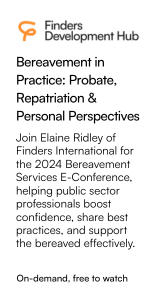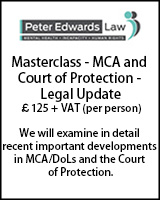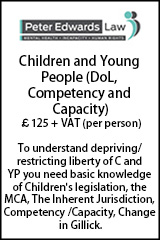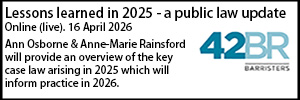Capacity, insight and professional cultures
- Details
Alex Ruck Keene KC (Hon) looks at an important new decision from the Court of Protection where the judge identified an evidential divide on capacity between social workers and clinicians.
CT v London Borough of Lambeth & Anor [2025] EWCOP 6 (T3) is in many ways the companion piece to Re Thirumalesh (Dec’d) [2024] EWCA Civ 896). In the latter case, the Court of Appeal made clear that the fact that a person appeared not to believe information that they were being told could not be used as a shortcut to reach the conclusion that they lacked capacity to make the relevant decision. In CT, Theis J has made clear that the same applies in relation to insight. At first instance, HHJ Beckley had concluded that CT:
25. […] cannot use or weigh ‘the fact that he has mental impairments and that these lead to specific care needs and impact on his wider decision-making ability’ [33], ‘his own impulsivity, lack of planning ability and lack of foresight when he is making decisions about his care needs’ [34], ‘the knowledge of his mental impairments’ [35], ‘the impact of [CT’s] mental impairment [39], that CT is unaware that the impact of his mental impairment ‘leads to a lack of foresight when weighing the consequences of refusing treatment’ [40] and ‘on his impulsivity means he is unable to weigh that impulsivity when making decisions’ [40], the inability to weigh the likely outcome of the refusal of care [43] and the impact that ‘his mental impairment has on his acceptance of care provision explains the history of admission to and self-discharge from previous placements’ [45].
On appeal, Theis J accepted the submissions of the Official Solicitor in relation to the first ground of her appeal on behalf of CT:
53. […] that the Judge fell into error when he set the bar too high in considering the relevant information for CT on the facts of this case, in particular that CT’s mental impairments are relevant information that he needs to understand and use and weigh.
54. The course taken by the Judge conflates the two stage test set out in JB and creates a circular approach that risks leading to the inevitable conclusion that those who have a mental impairment lack capacity. Such an approach undermines the principles and safeguards in the MCA 2005.
55. What is required is a careful delineation of the relevant information, relevant to the particular case in question, and then an assessment, in accordance with the statutory framework, whether the individual can understand, retain, use/weigh that relevant information and communicate the decision. It is only when that process concludes that the individual is unable to make a decision within that statutory framework that the court then has to consider whether the inability is ‘because of, an impairment of, or a disturbance in the functioning of, the mind or brain’. In the Judge’s judgment that important delineation was not present or clear.
The Official Solicitor also appealed on the basis that:
39. […] the intention of the MCA 2005, as explained in the JB case, is to focus on the functional assessment in the first instance, without considering the individual’s mental impairment. This is an important safeguard for those with mental impairments. The Judge’s approach in this case of including in the list of relevant information insight into mental impairment had the effect that he did not conduct the functional test in accordance with the MCA 2005, separately as set out by Lord Stephens in JB. Ms Bicarregui submits the Judge’s approach in the judgment had the effect of conflating and blurring the two stage test. There was no effective analysis of the relevant information, the Judge’s assessment of whether CT could use or weigh the information or engage with the differences in outcome between the assessments undertaken by the social workers and the clinicians. It is submitted the judge erred in carrying out the functional test with reference to CT’s mental impairment and in not resolving the key evidential dispute regarding the functional test with those who had assessed CT’s capacity.
40. The focus of the third ground of appeal is that assessments of capacity are time and decision specific. The assessments of the clinicians that CT lacked capacity dated from CT’s time in hospital, around the time the proceedings were started. The more recent assessments considered CT had capacity. It is submitted whilst this difference is referred to by the Judge at paragraphs [20] and [22], he does not explain why the more recent assessments should not be preferred.
Although not necessary for the purposes of the outcome of the appeal, Theis J also accepted that both of these grounds were made out:
57. The two stage test in JB is clear. The approach in this case of including insight into his mental impairment had the effect that the Judge did not conduct the functional test in accordance with the requirements of the MCA 2005. By taking that into account the Judge conflated and risked blurring the two distinct tests. This was caused by not taking the structured approach of going through the list of information identified as being relevant, resolving the relevant issues in the written and oral evidence and setting out the Judge’s assessment of whether CT can use/weigh the information. In effect, the Judge’s conclusion on the first stage was determined by CT’s mental impairment and not by resolving the key evidential dispute in respect of the functional test.
58. In relation to ground three there was evidence from the social work assessments, in particular the more recent ones, that CT had capacity to take decisions about his residence and care. Whilst the Judge refers to these assessments he did not properly take into account the evidence that pointed towards CT having a better understanding that his physical state had changed progressively and had insight into his increasing frailty. Whilst it is accepted that this experienced Judge had the benefit of hearing the oral evidence it was nevertheless important that he explained why the later assessments fell into error and were not capable of being relied upon.
Theis J noted that:
59. It is a striking feature of this case that the evidential divide on capacity was largely between the clinicians and the social workers. The form used by the local authority in their capacity assessment promoted a structured approach to the assessment in accordance with the statutory framework. It identifies the decision, sets out the relevant information the person must understand, retain, use or weigh in regard to the decision, includes what has been done to enhance the capacity of the person to maximise their ability to make the decision for themselves, and then cross checks the person’s ability to communicate. It then requests a summary of the options that have been discussed with the person. The form then structures each stage of the requirements in s3 MCA 2005 (understand, retain, use, weigh, communicate). In terms of structure the capacity assessment of Ms G, the allocated social worker, in May 2024 was an excellent example of providing both relevant detail at each stage, with clear reasoning to underpin conclusions. This high standard was replicated in the management scrutiny of that assessment by Ms M, the interim Team Manager. In comparison some of the assessments by the clinicians were in a less structured format. I recognise this may have been due to the particular circumstances at the time, but future assessments will benefit from more closely following the statutory framework in the way Dr M detailed in her witness statement in May 2024. As capacity assessments are time and decision specific, the relevant dates when the individual was assessed should always be clearly set out and borne in mind.
Counsel for CT and for Mind (who had intervened in writing) had provided checklists to assist those assessing capacity. “Whilst not wanting to add to the growing industry of checklists,” Theis J “recognise[d] they may be useful and have adapted them as follows:
(1) The first three statutory principles in s 1 MCA 2005 must be applied in a non-discriminatory manner to ensure those with mental impairments are not deprived of their equal right to make decisions where they can be supported to do so.
(2) In respect of the third principle regarding unwise decisions, particular care must be taken to avoid the protection imperative and the risk of pathologising disagreements.
(3) As set out in A Local Authority v JB [2021] UKSC 52, whether the person is able to make the decisions must first be addressed. Only if it is proven that one or more of the statutory criteria are not satisfied should the assessor them proceed to consider whether such inability is because of a mental impairment.
(4) Those assessing capacity must vigilantly ensure that the assessment is evidence-based, person-centred, criteria-focussed and non-judgmental, and not made to depend, implicitly or explicitly, upon the identification of a so-called unwise outcome.
(5) Insight is a clinical concept, whereas decision making capacity is a legal concept. Capacity assessors must be aware of the conceptual distinction and that, depending on the evidence, a person may be able to make a particular decision even if they are described as lacking insight into their general condition.
(6) In some cases, a lack of insight may be relevant to, but not determinative of, whether the person has a mental impairment for the purposes of s2 MCA 2005.
(7) When assessing and determining the legal test for mental capacity, all that is required is the application of the statutory words in ss2-3 MCA 2005 without any gloss; having ‘insight’ into mental impairment is not part of that test.
(8) Relevant information will be different in each case but will include the nature of the decisions, the reason why the decision is needed, and the likely effects of deciding one way or another, or making no decision at all.
(9) The relevant information is to be shared with the individual and the individual should be supported to understand the relevant information. The individual is not required to identify relevant information him/herself.
(10) If a lack of insight is considered to be relevant to the assessment of capacity, the assessor must clearly record what they mean by a lack of insight in this context and how they believe it affects, or does not affect, the person’s ability to make the decision as defined by the statutory criteria, for example to use/weigh relevant information.
Comment
For those wanting to think more about the apparent lack of insight of a person into their own situation, and how to translate such a situation into the language of the MCA, this may help.
Three other observations about this case:
- Theis J was clearly taken by the structured approach to capacity prompted by the relevant forms used by the local authority. Such a structure is undoubtedly very helpful, but it is vital that it follows the correct ordering of the capacity test – as is sadly still not often the case (a situation not helped by the fact that the Code of Practice directs people incorrectly).
- The flashpoint in this case was around discharge from hospital (in particular in a situation where one potential option had been discharge to be street homeless). Capacity in the context of homelessness is a notoriously difficult area, not least because it is so often loaded with assumptions about individuals, and also capacity being used as a gatekeeper by organisations with stretched resources: see further here.
- Capacity in the context of discharge from hospital is frequently a flashpoint because of (1) confusion about what decision is actually in issue (as to which, see here); and (2) because of professional cultural differences between the professions involved, of which distinct traces appear in this case. Frequently in my experience, these can be papered over by people talking about “fluctuating capacity,” when the reality is that there is a disagreement about the person’s capacity which requires identification and resolution.
Alex Ruck Keene KC (Hon) is a barrister at 39 Essex Chambers. This article first appeared on his Mental Capacity Law and Policy blog.













































